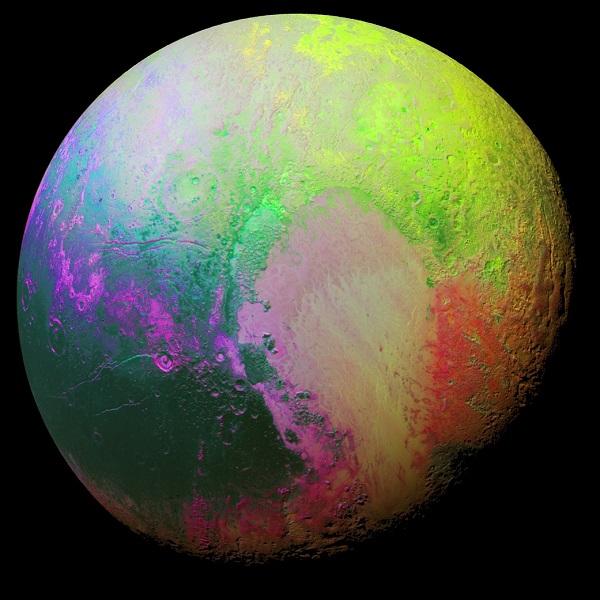The Science Behind Pluto's Psychedelic Colors
| Ana Verayo | | Nov 16, 2015 03:12 AM EST |
(Photo : NASA/JHUAPL/SwRI) The psychedelic colors of this new false color image of Pluto reveals the dwarf planet's complex surface features.
Prior to the epic flyby of Pluto courtesy of NASA's New Horizons probe last July, Pluto only appeared as a fuzzy, vague spot and now, New Horizons is streaming back a deluge of data that reveals the alien world's complex, icy plains and even mountain ranges, including crucial information about the dwarf planet's tenuous atmosphere.
Like Us on Facebook
The mission is now revealing unprecedented views of Pluto that are never before seen in high definition images, unraveling a complex and dynamic world where scientists once thought that this would not exist in a distant, icy region of the solar system.
Planetary scientists are now finding out for the first time the different surface features of the planet, revealing a diverse world that is now being mapped out, as scientists produced a psychedelic image of Pluto, pockmarked with blotches of vivid, contrasting colors.
Apart from the dwarf planet looking like a work of art, this is the New Horizons team's interpretation of Pluto's hemisphere, that also serves a critical scientific purpose. Using a technique called the principal component analysis, scientists utilized this to examine the changes in surface and terrain composition.
This particular new image was produced by the onboard Ralph/MVIC color camera last July 14 when the spacecraft was making its closest approach on Pluto, some 22,000 miles away.
This false color view of the dwarf planet is direct evidence how complex the dwarf planet is. Vibrant hues and colors differentiate Pluto's various regions, as plains and canyons are immediately evident.
It's also obvious which ones are the older regions, particularly revealed by the Pioneer Terra region in the north which is heavily cratered and the younger regions of Sputnik Planum where new ice flows, located at the western part of Tombaugh Regio, also known as Pluto's famous "heart". Shadows are also seen overcasting the bizarre, snakeskin or dragon scaled plains in the Tartarus Dorsa region.
To date, the New Horizons spacecraft is venturing more than a million miles beyond Pluto's region, into the Kuiper Belt, where precious data is now streaming back to Earth, taking a period of months for all of it to be completely transmitted.
These new findings are presented at the Division for Planetary Sciences meeting held by the American Astronomical Society.
TagsThe Science Behind Pluto's Psychedelic Colors, dwarf planet pluto, NASA New Horizons, psychedelic colors pluto, new image pluto, psychedelic pluto, new horizons pluto, NASA new horizons pluto
©2015 Chinatopix All rights reserved. Do not reproduce without permission
EDITOR'S PICKS
-

Did the Trump administration just announce plans for a trade war with ‘hostile’ China and Russia?
-

US Senate passes Taiwan travel bill slammed by China
-

As Yan Sihong’s family grieves, here are other Chinese students who went missing abroad. Some have never been found
-

Beijing blasts Western critics who ‘smear China’ with the term sharp power
-

China Envoy Seeks to Defuse Tensions With U.S. as a Trade War Brews
-

Singapore's Deputy PM Provides Bitcoin Vote of Confidence Amid China's Blanket Bans
-

China warns investors over risks in overseas virtual currency trading
-

Chinese government most trustworthy: survey
-

Kashima Antlers On Course For Back-To-Back Titles
MOST POPULAR
LATEST NEWS
Zhou Yongkang: China's Former Security Chief Sentenced to Life in Prison

China's former Chief of the Ministry of Public Security, Zhou Yongkang, has been given a life sentence after he was found guilty of abusing his office, bribery and deliberately ... Full Article
TRENDING STORY

China Pork Prices Expected to Stabilize As The Supplies Recover

Elephone P9000 Smartphone is now on Sale on Amazon India

There's a Big Chance Cliffhangers Won't Still Be Resolved When Grey's Anatomy Season 13 Returns

Supreme Court Ruled on Samsung vs Apple Dispute for Patent Infringement

Microsoft Surface Pro 5 Rumors and Release Date: What is the Latest?










